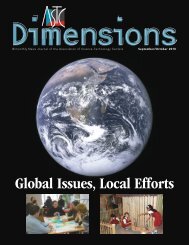Scientists Speak about Nano - Association of Science - Technology ...
Scientists Speak about Nano - Association of Science - Technology ...
Scientists Speak about Nano - Association of Science - Technology ...
Create successful ePaper yourself
Turn your PDF publications into a flip-book with our unique Google optimized e-Paper software.
Except for those who spend their<br />
time in laboratories, constrained<br />
by empirical experience, comprehending<br />
science at the nanoscale<br />
takes an extreme act <strong>of</strong> the imagination.<br />
It requires conjuring up an utterly foreign<br />
world—a remote world populated<br />
by atoms and molecules, a place our<br />
bodies can’t go and our minds are ill<br />
equipped to grasp.<br />
As museum educators, we need to<br />
remind ourselves just how cognitively<br />
difficult this is. Astronomy is far easier<br />
on the mind. Travel and acceleration<br />
are everyday experiences: Just extrapolate<br />
from car travel to warp speed, and<br />
you’ve wrapped your head around<br />
intergalactic distances. There is no<br />
similar experiential basis for shrinking<br />
to the size <strong>of</strong> DNA. Likewise, the<br />
mental time travel <strong>of</strong> paleontology is<br />
simpler to imagine than nanoscale science.<br />
Imagining distant eras is far more<br />
natural than picturing a world <strong>of</strong> detail<br />
inside a grain <strong>of</strong> sand. (And giant reptiles<br />
make it so much more engaging.)<br />
Stories <strong>about</strong> miniature worlds,<br />
found in many cultures, reveal only<br />
that people hope for shrunken realms<br />
more familiar than they really are. If<br />
the nanoscale turned out to be populated<br />
with fairies or Lilliputians, we<br />
would have a much easier time talking<br />
<strong>about</strong> it. But it is not, and we are left<br />
probing, picturing, and trying to<br />
explain a world that is hard to get to<br />
and contains little that is familiar.<br />
Which brings us to the need for art.<br />
Artists could be described as pr<strong>of</strong>essional<br />
explorers <strong>of</strong> perception and<br />
imagination, people whose life’s work<br />
is to specialize in the edges <strong>of</strong> cognition<br />
and help others to see and feel<br />
new things. Unlike scientific illustrators,<br />
who typically avoid ambiguity for<br />
the sake <strong>of</strong> educational clarity, artists<br />
revel in the murky territory where<br />
aesthetics, emotions, and cultural<br />
meaning come together. Who better,<br />
then, to make the invisible not just visible,<br />
but also compelling and relevant?<br />
Finding the art in nanoscience<br />
It was with this affective and cultural<br />
content in mind that, in 2006, the<br />
Exploratorium began to survey artistic<br />
investigations <strong>of</strong> nanoscale science.<br />
This effort was part <strong>of</strong> several directions<br />
pursued by NISE Net’s Visualization<br />
Laboratory team.<br />
We took stock <strong>of</strong> the relevant literature.<br />
We held weeklong, exploratory<br />
residencies with artists who had either<br />
worked directly with nanoscale science<br />
or demonstrated a style that seemed<br />
appropriate for it. We commissioned<br />
exploratory artworks and displayed<br />
previously produced works in a gallery<br />
on the museum floor. We worked with<br />
ASTC Dimensions • January/February 2008 9<br />
Visualizing the Invisible:<br />
At the Frontier <strong>of</strong> Art and <strong>Nano</strong>science<br />
By Tom Rockwell<br />
In the immersive digital interactive<br />
Zero@Wavefunction, bucky-ball projections<br />
are manipulated by the viewer’s shadow.<br />
The IDI was created by artist Victoria<br />
Vesna and s<strong>of</strong>tware designer Josh Nimoy<br />
in 2003, in collaboration with nanoscientist<br />
James Gimzewski. Photo by Pete Conolly<br />
Leonardo, the journal <strong>of</strong> the International<br />
Society for the Arts, <strong>Science</strong>s<br />
and <strong>Technology</strong>, to solicit a selection <strong>of</strong><br />
papers on art and nanoscale science<br />
and technology. And we collaborated<br />
with the Magic Theater in San Francisco<br />
as they, with support from the<br />
Sloan Foundation, commissioned short<br />
plays <strong>about</strong> nanotechnology. Reflections<br />
on this survey, along with the<br />
artists’ works, can be found at www.<br />
nisenet.org/artnano.<br />
What the process revealed is a territory<br />
that is still young, diverse, and<br />
incomplete—a kind <strong>of</strong> frontier town<br />
full <strong>of</strong> exploration and start-up businesses.<br />
Its denizens include artists like<br />
Victoria Vesna, Zack Booth Simpson,<br />
and Santiago Ortiz—all <strong>of</strong> whom have<br />
been working on nanoscale science for<br />
some time, exploring the same issues <strong>of</strong><br />
scale and digital modeling that<br />
nanoscale educators grapple with. Present,<br />
too, are scientists like Eric Heller<br />
and Don Eigler, who manipulate<br />
visualization-based experimental data<br />
or computational simulations in ways<br />
that resemble art, as well as artists like<br />
Stephanie Maxwell and Scott Snibbe,<br />
who are new to nanoscale science but<br />
bring an interesting sensibility to the<br />
table. Each is responding to and participating<br />
in an open-ended cultural<br />
exploration <strong>of</strong> a new topic—a broad,<br />
diverse, interdisciplinary topic that is<br />
well funded but still very much in flux.<br />
What we learned<br />
Space does not permit a full account <strong>of</strong><br />
our survey <strong>of</strong> nanoscale science and<br />
art, but I can share, in the form <strong>of</strong><br />
personal observations, some lessons<br />
learned in the process.<br />
The shapes and images <strong>of</strong> the nanoscale,<br />
once they are manipulated, can<br />
have a strong abstract appeal. Colorized





